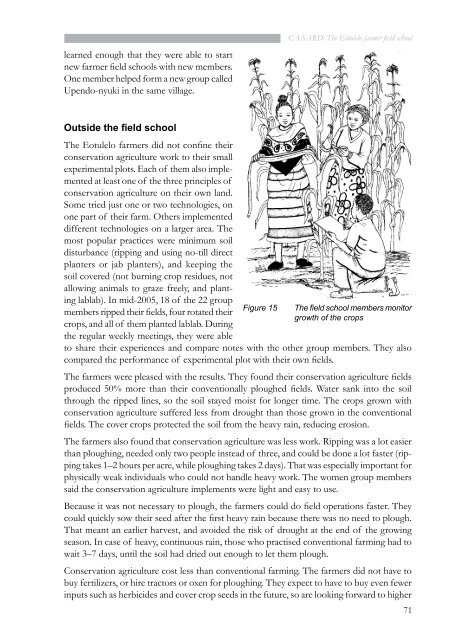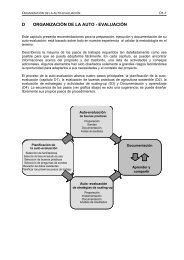cases from tanzania - Sustainet
cases from tanzania - Sustainet
cases from tanzania - Sustainet
Create successful ePaper yourself
Turn your PDF publications into a flip-book with our unique Google optimized e-Paper software.
learned enough that they were able to start<br />
new farmer field schools with new members.<br />
One member helped form a new group called<br />
Upendo-nyuki in the same village.<br />
Outside the field school<br />
The Eotulelo farmers did not confine their<br />
conservation agriculture work to their small<br />
experimental plots. Each of them also implemented<br />
at least one of the three principles of<br />
conservation agriculture on their own land.<br />
Some tried just one or two technologies, on<br />
one part of their farm. Others implemented<br />
different technologies on a larger area. The<br />
most popular practices were minimum soil<br />
disturbance (ripping and using no-till direct<br />
planters or jab planters), and keeping the<br />
soil covered (not burning crop residues, not<br />
allowing animals to graze freely, and planting<br />
lablab). In mid-2005, 18 of the 22 group<br />
members ripped their fields, four rotated their<br />
crops, and all of them planted lablab. During<br />
the regular weekly meetings, they were able<br />
CA-SARD: The Eotulelo farmer field school<br />
Figure 15 The field school members monitor<br />
growth of the crops<br />
to share their experiences and compare notes with the other group members. They also<br />
compared the performance of experimental plot with their own fields.<br />
The farmers were pleased with the results. They found their conservation agriculture fields<br />
produced 50% more than their conventionally ploughed fields. Water sank into the soil<br />
through the ripped lines, so the soil stayed moist for longer time. The crops grown with<br />
conservation agriculture suffered less <strong>from</strong> drought than those grown in the conventional<br />
fields. The cover crops protected the soil <strong>from</strong> the heavy rain, reducing erosion.<br />
The farmers also found that conservation agriculture was less work. Ripping was a lot easier<br />
than ploughing, needed only two people instead of three, and could be done a lot faster (ripping<br />
takes 1–2 hours per acre, while ploughing takes 2 days). That was especially important for<br />
physically weak individuals who could not handle heavy work. The women group members<br />
said the conservation agriculture implements were light and easy to use.<br />
Because it was not necessary to plough, the farmers could do field operations faster. They<br />
could quickly sow their seed after the first heavy rain because there was no need to plough.<br />
That meant an earlier harvest, and avoided the risk of drought at the end of the growing<br />
season. In case of heavy, continuous rain, those who practised conventional farming had to<br />
wait 3–7 days, until the soil had dried out enough to let them plough.<br />
Conservation agriculture cost less than conventional farming. The farmers did not have to<br />
buy fertilizers, or hire tractors or oxen for ploughing. They expect to have to buy even fewer<br />
inputs such as herbicides and cover crop seeds in the future, so are looking forward to higher<br />
71




